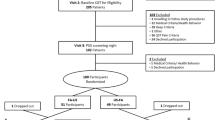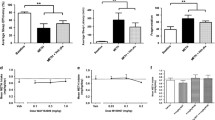Summary
After 4 adaptation nights, IM doses of morphine sulfate (7.5, 15, 30 mg/70 kg) and placebo were studied in 8 male postaddicts, using a cross-over design with randomized block analysis to demonstrate significant drug effect. Morphine decreased the number and duration of REM periods, delayed the onset of the first REM period, and possibly increased the time between REM period onsets. Thus, morphine significantly decreased REM state (REMS), but did not alter the pattern of maximum REMS in late night. Morphine significantly increased waking state (WS) but did not alter the pattern of maximum WS in early night. Morphine significantly increased tension, and shifted maximum tension from early night to middle night. Morphine altered EEG sleep patterns; although NREM definitions were thus less certain, morphine appeared to increase NREM light sleep (stages 1 and 2) and decrease NREM deep sleep (stages 3 and 4). After an initial decrease in REMS by 30 mg/70 kg of morphine, an increase in REMS was noted in the third night of the 2 pilot study subjects. The arousal response to morphine seen in post-addicts needs further study in other populations and during the course of chronic morphine use.
Similar content being viewed by others
References
Andrews, H. L.: Brain potentials and morphine addiction. Psychosom. Med. 3, 399–409 (1941).
—: Changes in the electroencephalogram during a cycle of morphine addiction. Psychosom. Med. 5, 143–147 (1943).
Aserinsky, E., and N. Kleitman: Regularly occurring periods of eye motility, and concurrent phenomena, during sleep. Science 118, 273–274 (1953).
Baekeland, F.: Pentobarbital and dextroamphetamine sulfate: effect on the sleep cycle in man. Psychopharmacologia (Berl.) 11, 388–396 (1967).
Beecher, H. K.: Measurement of subjective responses; quantitative effects of drugs. 1st ed. New York: Oxford University Press 1959.
Berger, H.: Über das Elektrencephalogramm des Menschen. Arch. Psychiat. Nervenkr. 94, 16–60 (1931).
—: Über das Elektrencephalogramm des Menschen. XIII. Mitteilung. Arch. Psychiat. Nervenkr. 106, 577–584 (1937).
Christison, R.: Employment of muriate of morphine in medicine. Edinb. med. S. J. 35, 331–338 (1831).
Dement, W., and N. Kleitman: Cyclic variations in EEG during sleep and their relation to eye movement, body motility, and dreaming. Electroenceph. clin. Neurophysiol. 9, 673–690 (1957).
Gibbs, F. A., E. L. Gibbs, and W. G. Lennox: Effect on the electro-encephalogram of certain drugs which influence nervous activity. Arch. intern. Med. 60, 154–166 (1937).
—, and G. L. Maltby: Effect on the electrical activity of the cortex of certain depressant and stimulant drugs—barbiturates, morphine, caffeine, benzedrine and adrenalin. J. Pharmacol. exp. Ther. 78, 1–10 (1943).
Haertzen, C. A.: Development of scales based on patterns of drug effects, using the Addiction Research Center Inventory (ARCI). Psychol. Rep. 18, 163–194 (1966).
Harley, J.: The old vegetable neurotics. Hemlock, opium, belladonna and henbane; their physiological action and therapeutical use alone and in combinations; being the Gulstonian Lectures of 1868, extended and including a complete examination of the active constituents of opium. Brit. med. J. 1, 343–345 (1868).
Hartmann, E.: The Biology of Dreaming. Springfield, Ill.: Ch. C. Thomas 1967.
Hill, A.B.: Principles of Medical Statistics, 7th ed. New York: Oxford University Press 1961.
Hill, H. E., C. A. Haertzen, A. B. Wolbach, and E. J. Miner: The Addiction Research Inventory: Standardization of scales which evaluate subjective effects of morphine, amphetamine, pentobarbital, alcohol, LSD-25, pyrahexyl and chlorpromazine. Psychopharmacologia (Berl.) 4, 167–183 (1963).
Jasper, H. H.: The ten twenty electrode system of the International Federation. Electroenceph. clin. Neurophysiol. 10, 371–375 (1958).
Jouvet, M.: Neurophysiology of the states of sleep. Physiol. Rev. 47, 117–177 (1967).
Kin, S.: Über Morphinismus. Keio J. Med. 4, 89–92 (1933).
Kreuger, H., N. B. Eddy, and M. Sumwalt: The pharmacology of the opium alkaloids. Suppl. 165, P. H. Reports (1941).
Lasagna, L., J. M. von Felsinger, and H. K. Beecher: Drug induced mood changes in man, I. Observations of healthy subjects, chronically ill patients and “postaddicts”. J. Amer. med. Ass. 157, 1006–1020 (1955).
Oswald, I., R. J. Berger, R. A. Jaramillo, K. M. G. Keddie, P. D. Olley, and G. B. Plunkett: Melancholia and barbiturates: A controlled EEG, body and eye movement study of sleep. Brit. J. Psychiat. 109, 66–78 (1963).
Rechtschaffen, A., and L. Maron: The effect of amphetamine on the sleep cycle. Electroenceph. clin. Neurophysiol. 16, 438–445 (1964).
Sertürner, F. W.: De la morphine et de l'acide méconique, considérés comme parties essentielles de l'opium. Ann. de chim. et phys. 5, 2s, 21 (1817).
Snedecor, G.: Statistical methods, 5th ed. Ames: Iowa State College Press 1956.
Snyder, F.: Progress in the new biology of dreaming. Amer. J. Psychiat. 122, 377–391 (1965).
von Felsinger, J. M., L. Lasagna, and H. K. Beecher: Drug-induced mood changes in man, 2. Personality and reactions to drugs. J. Amer. med. Ass. 157, 1113–1119 (1955).
Wikler, A.: Clinical and electroencephalographic studies on the effects of mescaline, N-allylnormorphine and morphine in man. J. nerv. ment. Dis. 120, 157–175 (1954).
Williams, R. L., H. W. Agnew, and W. B. Webb: Sleep patterns in young adults: an EEG study. Electroenceph. clin. Neurophysiol. 17, 376–381 (1964).
Wood, A.: New method of treating neuralgia by the direct application of opiates to the painful points. Edinb. med. S. J. 82, 265–281 (1855).
Author information
Authors and Affiliations
Additional information
A summary of this data was presented at the 8th annual meeting of the Association for the Psychophysiological Study of Sleep, March 22–24, 1968, in Denver, Colorado. An abstract of this data is included in the APSS papers published in Psychophysiology 5 (2), 198–245, September 1968. A summary was also presented at the 31st annual meeting of the Committee on Problems of Drug Dependence, National Research Council, Palo Alto, February 24–26, 1969.
Rights and permissions
About this article
Cite this article
Kay, D.C., Eisenstein, R.B. & Jasinski, D.R. Morphine effects on human REM state, waking state and NREM sleep. Psychopharmacologia 14, 404–416 (1969). https://doi.org/10.1007/BF00403581
Received:
Issue Date:
DOI: https://doi.org/10.1007/BF00403581




